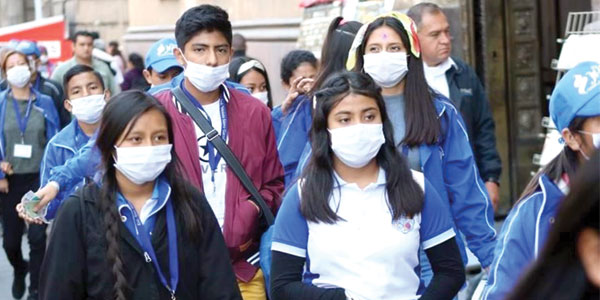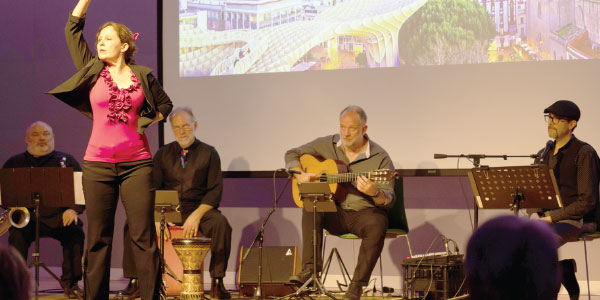
By Jorge Ramos
How many times will you touch your face while reading this article? The answer is: a lot. It’s normal to touch your face, or at least it was. Touching your mouth or nose, or greeting other people with a kiss or handshake, were normal things people did before the coronavirus arrived. But these casual behaviors, so much a part of us, also explain why the virus spread so quickly around the globe. It brutally attacked our faces! It loves our mouths, our eyes, even our noses.
Our daily lives have changed drastically in just a few months, and, as time goes by, we wonder if this will be the new normal. Perhaps it should be.
Students participating in a study at the University of New South Wales touched their faces an average of 23 times in just one hour. And 44% of these touches involved the students’ mucous membranes (their eyes, noses or mouths), which are entry portals for the coronavirus. Other research, published in the Journal of the American Board of Family Medicine, found that health workers touched their eyes, noses or mouths an average of 19 times every two hours.
Both studies concluded that increased awareness of our face-touching habits could lead to improved hygiene and fewer infections.
Having seen these studies and having had a few coronavirus scares myself, I’m happy to report that I touch my face far less frequently than I used to. People today are developing a kind of inner alarm that goes off every time we do something — like scratching our nose or getting too close to another person in the absence of a face mask — that puts us in danger of getting infected. Of course, we weren’t always like that.
On March 1, a priest at Christ Church Georgetown in Washington, D.C., shook hands and celebrated Holy Communion with hundreds of congregants during Sunday services. Shortly afterward, news surfaced that the priest had tested positive for the coronavirus, and local authorities requested that parishioners who had recently come into contact with him self-isolate.
That was less than two months ago. Since then, our lives have been entirely upended. What was normal a year ago no longer applies. And we’re in this for the long haul. A study by researchers at the Harvard T.H. Chan School of Public Health suggests that “intermittent distancing may be required into 2022 unless critical care capacity is increased substantially or a treatment or vaccine becomes available.”
There is still so much we don’t know about how the virus will affect our lives. For example, I don’t know if my son Nicolás will be able to go back to college this fall or if his team will play football again anytime before 2021. Things aren’t looking good.
One thing we have learned is that every change in our behavior has very real consequences. Social distancing and strict stay-at-home measures have flattened the infection and death curves in several countries. The fact that billions of people are willing to change their behavior for the common good is both enlightening and encouraging. Their efforts must be applauded.
It may be the case that in the future many of us will greet each other with a hand held over our hearts or with our palms pressed together in a prayerlike gesture. I wonder what will become of the peculiar Mexican greeting consisting of a handshake, a hug that includes three pats on each other’s backs, and then another handshake.
The truth is that handshakes are in serious trouble. “I don’t think we should ever shake hands ever again, to be honest with you,” Dr. Anthony Fauci, the director of the National Institute of Allergy and Infectious Diseases, said in a recent Wall Street Journal podcast. Fauci, whose wise and thoughtful voice amid the crisis has served as a welcome reprieve from the president’s outbursts, added that avoiding handshakes would not only “be good to prevent coronavirus disease; it probably would decrease instances of influenza dramatically in this country.”
I’m reminded of Dr. Aileen Marty, an infectious-disease expert at Florida International University whom I’ve interviewed numerous times throughout my career. She would never shake my hand. Her experience with contagious diseases in countries around the world had taught her that handshakes could be deadly. We wouldn’t even bump fists before our interviews. Aileen taught me how to greet people with my elbow at a time when it was still seen as impolite to do so. In a way, she was preparing me — and all of us — for the worst-case scenario. She knew that an invisible enemy was always going to be lurking close by.
So then … how many times did you touch your face while reading this article?
_______________________________________________________________________________________________________________
La nueva normalidad después del coronavirus
¿Cuántas veces te vas a tocar la cara mientras lees esta columna? Muchas. Es, o era, normal: tocarnos la boca, saludarnos de beso, darnos la mano. Estas eran rutinas del mundo antes del coronavirus. Y esas costumbres, tan arraigadas en tantos de nosotros, explican por qué este virus se extendió vertiginosamente por todo el planeta. Ha sido un brutal ataque a través de nuestras caras. A este virus le gusta tu boca, tus ojos y tu nariz.
Nuestras rutinas, nuestras vidas, han cambiado en unos pocos meses y conforme pasa el tiempo nos preguntamos si esta será la nueva normalidad. Quizás deba serlo.
Los estudiantes que participaron en un estudio de la Universidad de New South Wales se tocaron la cara, en promedio, 23 veces cada hora. El 44 por ciento de esos contactos ocurrieron en áreas mucosas (ojos, nariz y boca). Y esas partes de la cara son zonas de cultivo para el coronavirus.
Otra investigación, publicada en el Journal of American Board of Family Medicine, encontró que los trabajadores médicos se tocaron los ojos, la nariz y la boca un promedio de 19 veces cada dos horas. Ambos estudios concluyeron que una mayor conciencia de todas las veces que nos tocamos la cara podría ayudar a una mejor higiene y menos infecciones.
Después de leer estos experimentos, y de pasar un par de sustos con el coronavirus, me toco mucho menos la cara. Estamos desarrollando una especie de alarma interna cada vez que hacemos algo —tocarnos la cara o superficies, acercarnos demasiado a alguien o ir al supermercado sin tapabocas— que nos ponga en peligro de contagio. Pero no siempre fue así.
El domingo primero de marzo, un sacerdote de la iglesia Christ Church Georgetown saludó de mano y les dio la comunión a cientos de personas. Bueno, poco después se supo que ese sacerdote dio positivo en la prueba del coronavirus y las autoridades locales de Washington D.C. les pidieron a los feligreses que estuvieron en contacto con él que se pusieran voluntariamente en cuarentena.
Eso ocurrió hace menos de dos meses y es increíble pensar cómo nos hemos transformado nuestras vidas desde entonces. La normalidad ya no será lo que fue en 2019. Y esto va para largo. Un estudio de investigadores de la Escuela de Salud Pública T.H. Chan de Harvard consideró que “el distanciamiento social intermitente será necesario hasta 2022, a menos de que la capacidad de los cuidados intensivos aumente sustancialmente o de que un tratamiento o una vacuna estén disponibles”.
Hay tantas cosas que no sabemos sobre esta enfermedad. Por ejemplo, como padre de un universitario, no sé si Nicolás va a regresar a la escuela este otoño y si podrá jugar futbol americano antes de 2021. Las cosas no pintan bien.
Lo que sí hemos aprendido es que los cambios de nuestro comportamiento tienen resultados muy concretos. El distanciamiento social y el estricto confinamiento en nuestras casas ha aplanado la curva de contagios y muertes en varios países. Es esperanzador y aleccionador cómo miles de millones de personas modifican su conducta por un bien común. Es, sin duda, para aplaudirnos.
En un futuro próximo quizás lo único que nos quede como saludo sea eso: aplaudirnos de lejitos, tocarnos con una mano el pecho (cerca del corazón) o unir las dos manos como en una plegaria. Y no sé en que va a quedar esa curiosa costumbre mexicana de saludarse de mano, luego darse un abrazo con tres palmaditas en la espalda y finalizar con otro fuerte apretón de manos.
De hecho, el futuro del saludo de manos está en serio peligro. “No creo que nos debamos saludar de mano otra vez”, dijo el doctor Anthony Fauci en un pódcast del Wall Street Journal. El director del Instituto Nacional de Alergias y Enfermedades Infecciones —quien se ha convertido en una voz sabia y precavida en esta crisis frente a los exabruptos del presidente de Estados Unidos— agregó que dejar de saludarse de mano “sería bueno para prevenir un contagio de coronavirus y reducir dramáticamente los casos de influenza en este país”.
Esto me recuerda a la doctora Aileen Marty, especialista en enfermedades infecciosas de la Universidad Internacional de la Florida (FIU), a quien en mi carrera ha entrevistado en varias ocasiones. Nunca saludaba de mano. El manejo de crisis infecciosas en varios países le había enseñado que saludar de mano podía ser mortal. Antes de nuestras entrevistas, ni siquiera nos tocábamos los puños. De hecho, ella fue la que me enseñó a saludar con los codos en una época en que todavía era visto como de mala educación y falta de modales. De alguna manera, ella nos preparaba para lo peor. Un enemigo invisible estaba por llegar.
Ahora sí. ¿Cuántas veces te tocaste la cara mientras leías esta columna?









